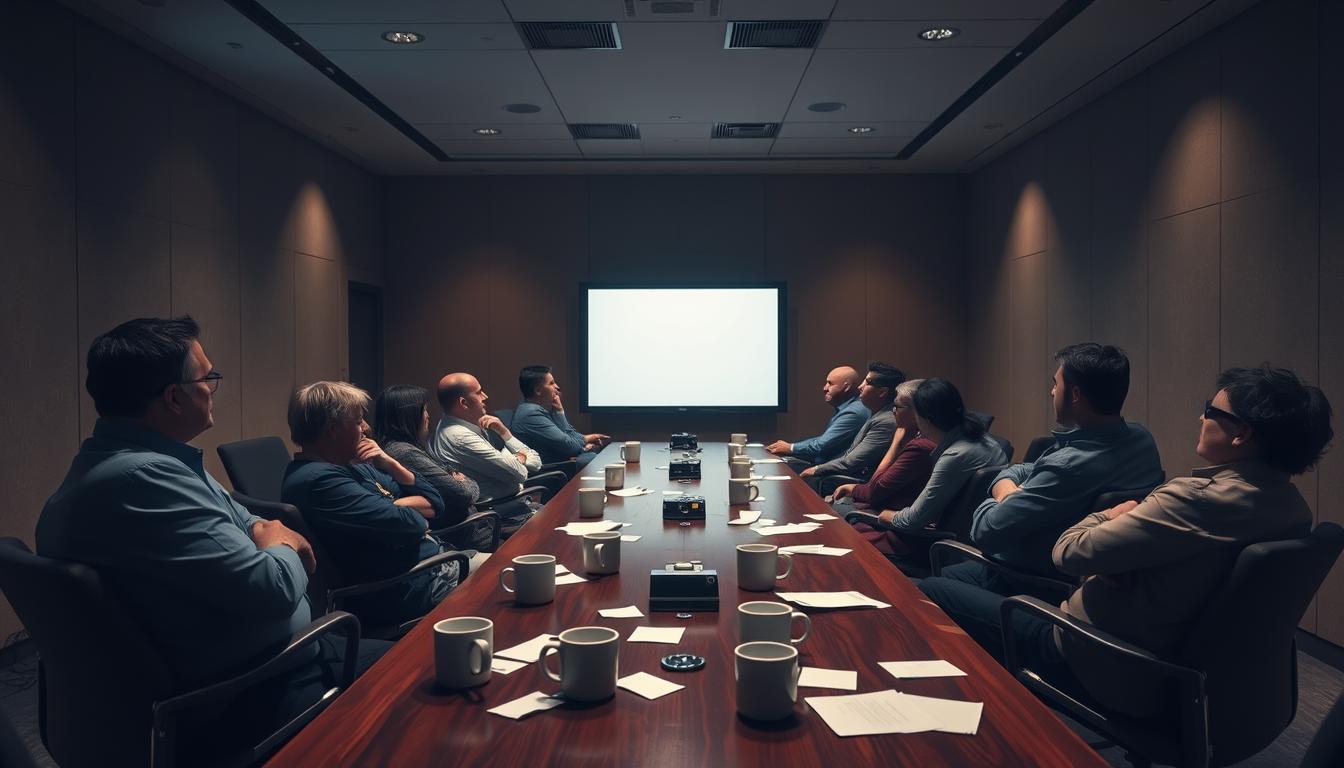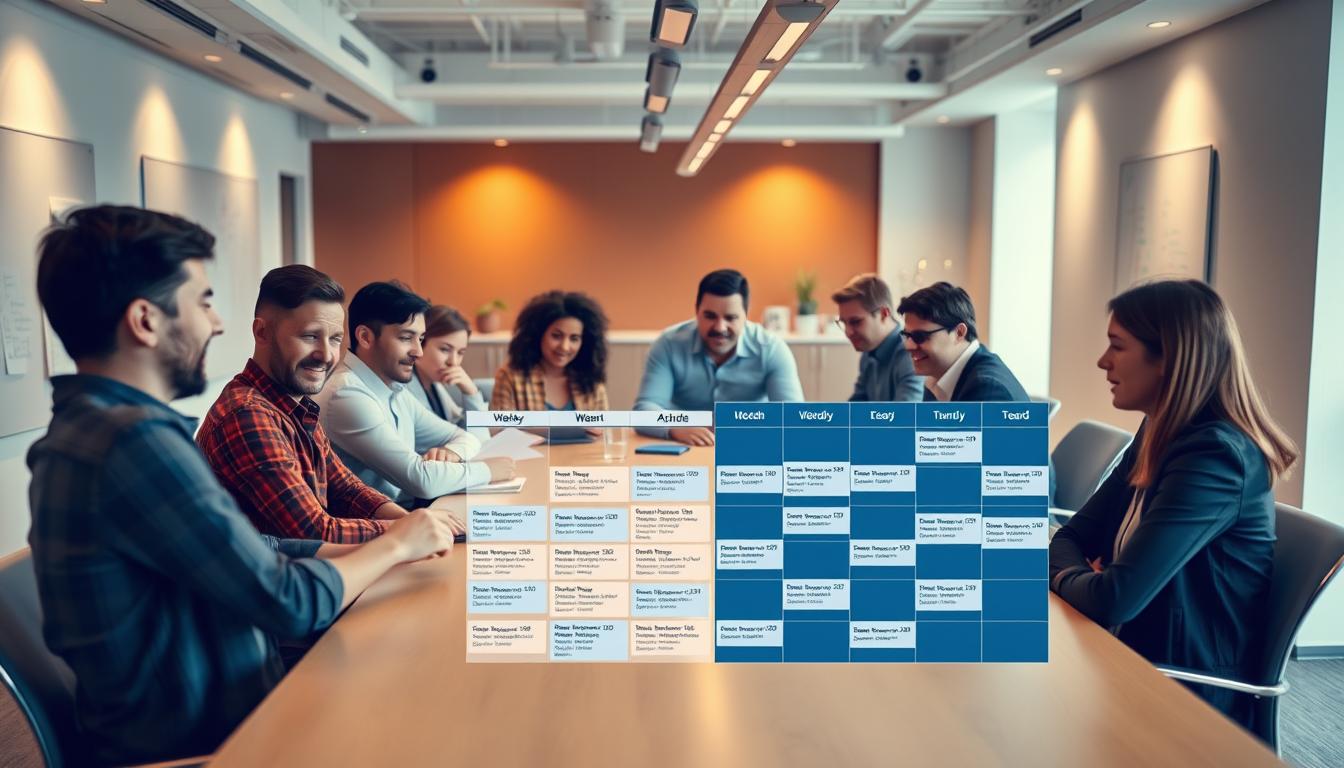In today’s fast-moving business world, making the most of office meetings is essential. The U.S. has around 11 million meetings every day. This shows how vital they are for improving work efficiency. Sadly, many of these meetings are not productive. They waste time and money, costing about $37 billion each year. This article will give you tips on how to make meetings better. We aim to help you run meetings that encourage teamwork and are truly effective.
The Current State of Office Meetings
Today’s workplaces are in a meeting crisis, leading to less efficient work environments. Studies reveal that 71% of top managers find their meetings useless. Workers dedicate around 392 hours annually to these meetings. This not only breaks up their workday but also adds to distractions.
The Meeting Crisis: Unproductive Trends
Too many meetings lack a clear purpose, making them unhelpful. This traps professionals in sessions that don’t improve their focus. These pointless meetings not only waste time. They also lower team spirit as staff feel they could use their time in better ways. It’s crucial for businesses to create meetings with clear goals.
Impacts of Inefficient Meetings on Productivity
Bad meetings can harm productivity deeply. Employees feel more stressed when they have too many ineffective meetings. This leads to less interest and lowers team happiness. Companies need to tackle these issues to boost productivity and focus.
Understanding Meeting Purpose
It’s crucial to set clear goals for meetings to boost productivity. By knowing what needs to be discussed, teams can focus on important matters. This could be making decisions, thinking of new ideas, or giving updates. Meetings work better when the right people are involved. This ensures that everyone communicates well. Research shows it’s vital to pick topics that need everyone’s input from those that don’t.
Defining Clear Objectives for Meetings
Goals for meetings must be clear and achievable. When goals are clear, everyone knows what’s expected and can get ready. This makes discussions in meetings stay on track. Teams need to:
- Clearly state the main goal of the meeting.
- Pick key topics to discuss that meet the meeting’s goals.
- Decide who should be there based on what needs to be achieved.
The Importance of Relevant Participation
Having the right people in the meeting is key to its success. When only involved people are there, discussions are better. This makes it easier to make decisions. To make sure the right people are at the table:
- Check what each person can bring to the meeting.
- Ask for ideas from those with unique perspectives.
- Think about whether someone can really add to the conversation.
Strategies to Optimize Office Meetings
Effective preparation boosts office meetings’ productivity. It’s vital to have good meeting strategies. They make the meeting’s goal clear and increase involvement. Key steps include having a solid plan and using tech tools.
Preparing a Structured Agenda
A strong agenda is key to a great meeting. Meetings with agendas sent out before are usually shorter and more engaging. To make a good agenda, you should:
- Make the meeting goals clear.
- Arrange topics sensibly.
- Set specific times for each topic.
- Give the agenda to participants early to help them prepare.
Utilizing Technology for Efficiency
Meeting technology makes things run smoother. Digital tools and software help share info quickly. The right tech cuts down on routine work, leading to better talks. With well-planned agendas, these tools support successful meetings.
Time Management in Meetings
Managing time well is key to successful meetings. Starting on time shows we respect each other’s time and are professional. It’s important to plan how long each part of the meeting will last. This helps keep discussions focused and productive.
Best Practices for Punctuality
Here are some tips to stay on schedule:
- Always start meetings when they’re supposed to start, no matter who’s there.
- Tell everyone why being on time matters. It helps make meetings more effective.
- Send out reminders and calendar invites early to make sure everyone is ready.
Allocating Time for Each Topic
Setting time limits for each topic helps everyone stay engaged. Try these steps:
- Figure out how long the meeting should be and plan time for each topic.
- Use timers or alerts to remind everyone when it’s time to change topics.
- Give out the agenda before the meeting so everyone can come prepared to discuss.
Enhancing Participation and Engagement
To get more done in meetings, it’s key to boost how much people are involved. Making a space where everyone feels they can talk and share ideas leads to smarter solutions. By using strategies that get everyone working together, discussions become richer and more creative outcomes emerge.
Encouraging Active Discussions
To get people talking more, there are several techniques you can try:
- Use structured turn-taking to ensure everyone has a chance to speak.
- Employ targeted questioning that prompts specific individuals or groups to share their insights.
- Encourage team members to build on each other’s ideas to foster a collaborative atmosphere.
Fostering Collaboration and Idea Sharing
For successful team work, it’s crucial to make everyone feel safe to express themselves. Here’s how to do that:
- Setting clear expectations for respectful dialogue and active listening.
- Allowing for informal brainstorming sessions to gather diverse perspectives.
- Incorporating interactive tools like digital whiteboards to visualize contributions.
Facilitating Effective Discussions
Running meetings well makes them better. By keeping the balance, everyone gets to speak their mind. From the start, it’s key to set rules so everyone knows how to be respectful and join in. This way, meetings are not just more inclusive but also more fruitful and engaging.
Managing Dominant Participants
Handling those who talk too much is key for a good meeting. There are ways to make sure everyone gets a turn:
- Use a round-robin approach to allow everyone to speak.
- Direct questions to quieter members, encouraging their input.
- Introduce time limits for individual contributions to maintain balance.
These methods help keep the focus on the goals of the discussion. They ensure that every person has a chance to contribute.
Setting Ground Rules for Respectful Dialogue
Making clear rules is vital for a respectful conversation. Good rules might be:
- No interrupting while others are speaking.
- Ensuring all opinions are treated with respect, regardless of disagreement.
- Commitment to keeping comments constructive and relevant.
With clear rules, facilitators can make discussions more effective. This creates a friendly environment that supports teamwork and growth.
Post-Meeting Follow-Up and Accountability
Good follow-up is key to a meeting’s success and better team work. Writing down the minutes well helps keep everyone on the same page about what was decided. This is how a team stays accountable for what they agreed to do.
Importance of Documenting Meeting Minutes
Writing down meeting minutes means keeping a detailed note of everything discussed. This prevents confusion and ensures everyone understands the decisions made. Having a set way to write minutes makes the process more effective.
Tracking Action Items and Responsibilities
After a meeting, it’s important to know who needs to do what. Clearly giving out tasks makes sure everyone knows their duties. Sharing the minutes quickly keeps tasks fresh in everyone’s mind, helping the team move forward without delays.
Using Analytics for Meeting Optimization
In today’s world, productive meetings are key for success. Many organizations use meeting analytics to get better. They look at meeting data like how often they happen, how long they last, and if people are really paying attention.
This helps them make meetings better and more useful for everyone’s work life.
Leveraging Data to Improve Meeting Effectiveness
Teams use analytics to figure out what makes a good meeting. For example, Flowtrace helps track important info. This includes how effective meetings are, how often they happen, and how focused people are during them.
Identifying Areas for Improvement
With the data, companies can see what needs to get better. They might find they’re having too many meetings. Or, decide if some meetings are even needed. Making changes based on data helps make meetings more important and useful.
Creating a Meeting Culture that Values Productivity
In today’s fast world, making a meeting culture focused on productivity is key for any successful business. Using no-meeting days allows everyone to work deeply without interruption. This approach boosts creativity and productivity, making a happier and more efficient team.
Implementing No-Meeting Days
No-meeting days are a great way for businesses to help employees focus and cut down on distractions. By setting aside days for uninterrupted work, people can focus on big projects without meeting interruptions. This helps improve both individual and team results significantly.
Encouraging Balanced Workflows between Meetings and Deep Work
It’s important to find a good mix of meeting time and deep work to keep productivity high. Creating schedules that balance team collaboration with solo work tasks helps promote better work habits. This leads to happier employees and better results for the company’s goals.

Conclusion
Improving office meetings is key to boosting productivity in any organization. Adopting specific strategies like setting clear goals and having structured agendas can make meetings more productive. These steps help create a place where employees do well, making meetings important and helpful.
Also, working well together is important for great meetings. By making everyone feel involved and encouraging open talks, teams can use everyone’s skills and ideas. This teamwork makes people feel more connected and can lead to new ideas that help the organization succeed.
In the end, when companies follow these tips, they make their teams work better together. By focusing on better meetings and overall performance, businesses will not just see higher productivity. They will also have a happier and more driven team.



